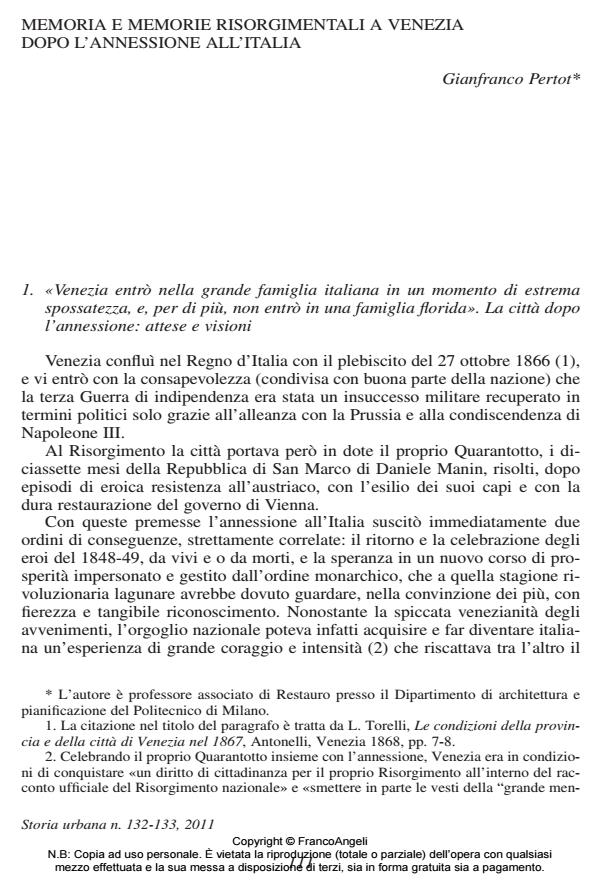Memoria e memorie risorgimentali a Venezia dopo l'annessione all'Italia
Titolo Rivista STORIA URBANA
Autori/Curatori Gianfranco Pertot
Anno di pubblicazione 2012 Fascicolo 2011/132
Lingua Italiano Numero pagine 53 P. 111-163 Dimensione file 6046 KB
DOI 10.3280/SU2011-132005
Il DOI è il codice a barre della proprietà intellettuale: per saperne di più
clicca qui
Qui sotto puoi vedere in anteprima la prima pagina di questo articolo.
Se questo articolo ti interessa, lo puoi acquistare (e scaricare in formato pdf) seguendo le facili indicazioni per acquistare il download credit. Acquista Download Credits per scaricare questo Articolo in formato PDF

FrancoAngeli è membro della Publishers International Linking Association, Inc (PILA)associazione indipendente e non profit per facilitare (attraverso i servizi tecnologici implementati da CrossRef.org) l’accesso degli studiosi ai contenuti digitali nelle pubblicazioni professionali e scientifiche
Il Risorgimento a Venezia ebbe il suo più fulgido episodio nell’esperienza della Repubblica di San Marco del 1848-49, che ebbe come protagonisti Daniele Manin, Niccolò Tommaseo e altri personaggi di spicco della cultura veneziana. Dopo l’annessione all’Italia (1866) i veneziani vollero innanzitutto ricordare gli eroi e le vicende di quel periodo. Anche a Venezia si costruirono monumenti al Re e a Garibaldi, ma mancò quell’opera capillare, estesa e continua di celebrazione dei protagonisti del Risorgimento, con manifesto intento di alfabetizzazione politica, quale si manifestò in molte altre città italiane nei primi decenni dopo l’Unità. Pochi furono i monumenti eretti (con molte polemiche, ritardi, contrasti fra istituzioni, comitati, rappresentanti delle élite della città) e pochi anche i cambiamenti nella toponomastica. Venezia dopo il 1866 era una città in profonda crisi economica, sociale e di identità. I modi contradditori con cui affrontò la celebrazione risorgimentali sono sintomo della difficile contingenza e della problematica convivenza fra il nuovo ordine moderato imposto con l’Unità (peraltro in sintonia con il patriziato, ancora saldamente rappresentato ai vertici del governo cittadino), il ricordo dell’eroica ma sfortunata esperienza rivoluzionaria del 1848-49 e quello, latente, dell’autonomia goduta fino al 1797.
Parole chiave:Venezia - Rivoluzione - Monumenti commemorativi - Identità
Gianfranco Pertot, Memoria e memorie risorgimentali a Venezia dopo l'annessione all'Italia in "STORIA URBANA " 132/2011, pp 111-163, DOI: 10.3280/SU2011-132005